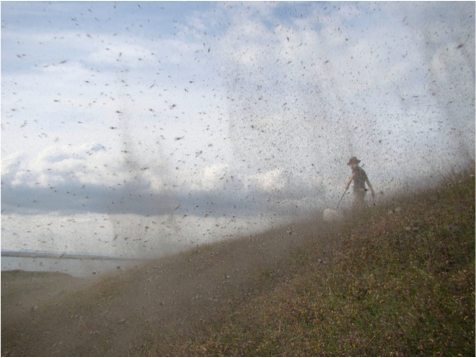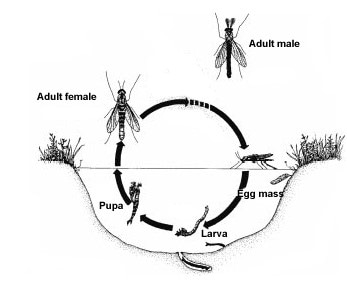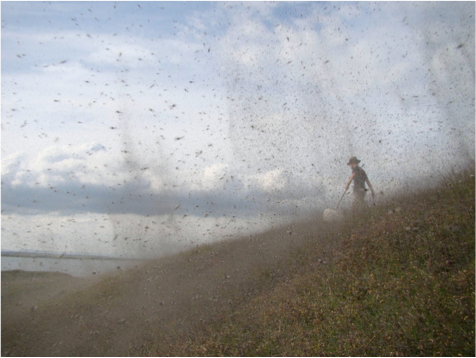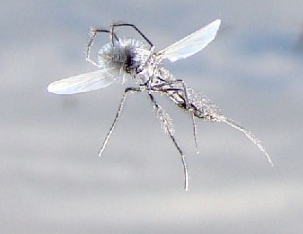|
Annual emergences of chronomid (non-biting) midges at the subarctic Lake Myvatn in northeastern Iceland are being studied for their interesting effects on arthropod food webs. Understanding the aquatic-terrestrial linkages in the near-shore ecosystems will shed light on the role midges play in the nitrogen cycle.
metric tons of dry biomass to the surrounding landscape, which is “roughly equivalent to 510,000 Big Macs” according to Gratton. These flies swarm around the lake in what are known as mating pillars, made up of mostly males, and can be seen up to a few miles away from the lake.
(low growing woody) found close to the lake (M. Raudenbush, MS Thesis). This change in plant composition near the lake has been suggested to be the result of a “fertilization effect” as midges quickly decompose and their bodies are made up of 10% nitrogen, which becomes available to the environment (Gratton et al. in review). The impacts of increased nitrogen are seen as far away as 500 m from Lake Myvatn (Dreyer et al. 2015). To better understand the effect that midge deposition has on plant communities, Gratton set up a multi-year addition experiment on a midge-less lake where small plots were supplemented with dried midges (biomass) and changes in the plant community were documented. Some plots received midge biomass multiple consecutive years (the press treatment) and others received midges for just one year (the pulse treatment). Results from this eight-year study indicate that plots that received the pulse treatment saw short-lived effects in terms of total nitrogen and small and inconsistent increase in plant biomass that was gone by the second growing season. While these effects were short-lived they were still comparable to conventional fertilizer. In the press treatments, total nitrogen continues to increase but eventually declines, while the plant biomass continues to grow. . Over the eight-year study, plant community composition
About the Authors: Olivia Bernauer is a Master’s student in Dennis vanEngelsdorp’s bee lab working to better understand the floral preferences of Maryland’s wild, native pollinators. Meghan McConnell is a Master’s student in Dennis vanEngelsdorp’s Lab studying honey bees with a focus on non-chemical control of varroa mites. After 5 years at UMD with the bee lab and Bee Informed Partnership, she will be the Delaware State Apiarist. References: Dreyer, J., Townsend, P. A., III, J. C. H., Hoekman, D., Vander Zanden, M. J. and Gratton, C. (2015), Quantifying aquatic insect deposition from lake to land. Ecology, 96: 499–509. doi:10.1890/14-0704.1 Dreyer, J., Hoekman, D. and Gratton, C. (2016), Positive indirect effect of aquatic insects on terrestrial prey is not offset by increased predator density. Ecol Entomol, 41: 61–71. doi:10.1111/een.12272 Einarsson, Á., Gardarsson, A., Gíslason, G. M. and Ives, A. R. (2002), Consumer–resource interactions and cyclic population dynamics of Tanytarsus gracilentus (Diptera: Chironomidae). Journal of Animal Ecology, 71: 832–845. doi:10.1046/j.1365-2656.2002.00648.x Ives, Anthony R., Árni Einarsson, Vincent A. A. Jansen, and Arnthor Gardarsson. 2008. “High-Amplitude Fluctuations and Alternative Dynamical States of Midges in Lake Myvatn.” Nature 452 (7183): 84–87. doi:10.1038/nature06610. Comments are closed.
|
Categories
All
Archives
June 2024
|
Department of Entomology
University of Maryland
4112 Plant Sciences Building
College Park, MD 20742-4454
USA
Telephone: 301.405.3911
Fax: 301.314.9290
University of Maryland
4112 Plant Sciences Building
College Park, MD 20742-4454
USA
Telephone: 301.405.3911
Fax: 301.314.9290





 RSS Feed
RSS Feed




